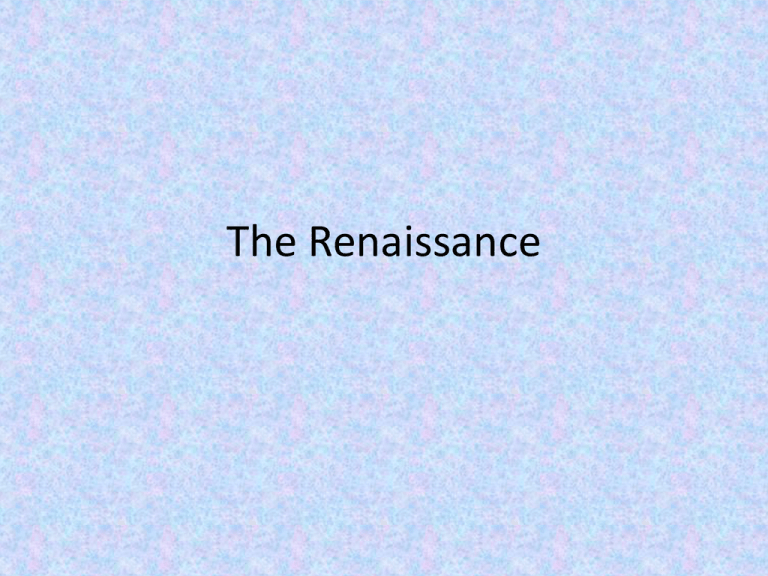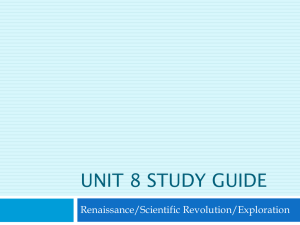The Renaissance
advertisement

The Renaissance Spirit of the Renaissance • Began in the city-states of northern Italy. • Spread to northern Europe and Spain. • City-states had become wealthy because of the Crusades. • Created a powerful middle-class of bankers and merchants. • Had the time and money to seek education and support the work of artists. Interest in the Classics • Learning of ancient Greece and Rome. • Read ancient texts. • Rediscovered knowledge that had been lost or forgotten during the Middle Ages. New views of the world • Europeans changed the way they thought about themselves. • Had strong religious views. • Read the works of early Christian writers. • Interested in secular affairs. • Focused on “how to behave”. • Machiavelli – “The Prince” – handbook for rulers – “safer to be feared than to be loved” Achievements of the Renaissance • Confidence in the ability of individuals to shape their own lives. • Stimulated a creative spirit that revolutionized the arts and world of learning in Western Europe. Art • Studied Greek statues and Roman buildings. • Works reflected realism and grace. • Experimented with new paints and paimting techniques. • Developed “perspective” – a method of painting that makes objects or scenes appear three-dimensional. • Leonardo da Vinci, Michelangelo Madonna and Child - Giotto Da Vinci – Benois Madonna Literature • Wrote on religious and secular subjects • Petrarch – wrote sonnets (a 14 line poem) most famous are love poems to “Laura” • Cervantes – Spaniard – Don Quixote – novel that mocks the ideals of medieval knights – the musical Man of La Mancha is based on this book. • Shakespeare – Romeo and Juliet - Hamlet The Printing Press • Johann Gutenberg invented a press using movable type. • Used to produce the first Bible printed by machine. • Meant books could be mass produced. • Spread new ideas more rapidly as more people learned to read. Age of Exploration • Motives – desire to bypass trade routes controlled by Muslims and Italian city-states. • Desire for gold and silver led to conquering of the Americas. • Wanted to spread Christianity to other lands. Impact of Technology • Renaissance mapmakers produced more accurate maps. • Astrolabe – could be used at sea to calculate latitude – didn’t have to hug the coastline. • Improved the magnetic compass • Adopted the lateen sail from the Arabs. • Used new shipbuilding techniques to build large, seaworthy ships. Voyages • 1488 – Bartholomeu Dias rounded the Cape of Good Hope at the southern tip of Africa. • 1498 – Vasco da Gama sailed around Africa to India. Led Portugal to build a rich trading empire in Asia. • 1492 – Christopher Columbus sailed to the New World. • Ferdinand Magellan circumnavigated the world. Effects of Expansion • Had worldwide impact • Spread foods, animals, and ideas from one continent to another. • Known as the Columbian Exchange. • Also introduced European disease to the New World. Wiped large populations of native americans. Colonies • Established colonies in the Americas and trading outposts in Asia. • Spain and Portugal divided South America. • Spain, France, the Netherlands, and England set up colonies in North America. • Supplied Europe with precious metals, foods, timber, and furs. • Led to increased warfare between nations competing for land and power. Economic Impact • • • • Changed the economy of Europe. Trade and commerce grew. Harbor cities grew in importance. Developed new ways of doing business – jointstock companies- raised capital for trade voyages. • Set up banks and insurance companies. • Helped European nations increase their power. • Rulers adopted the economic philosophy of mercantilism. • Colonies supplied the parent country with raw materials – parent country expanded industries to produce manufactured goods for the colonies.





